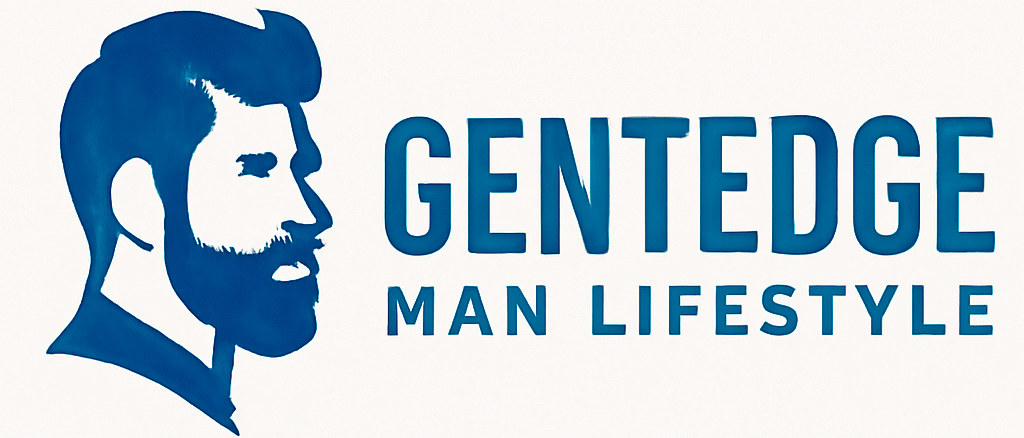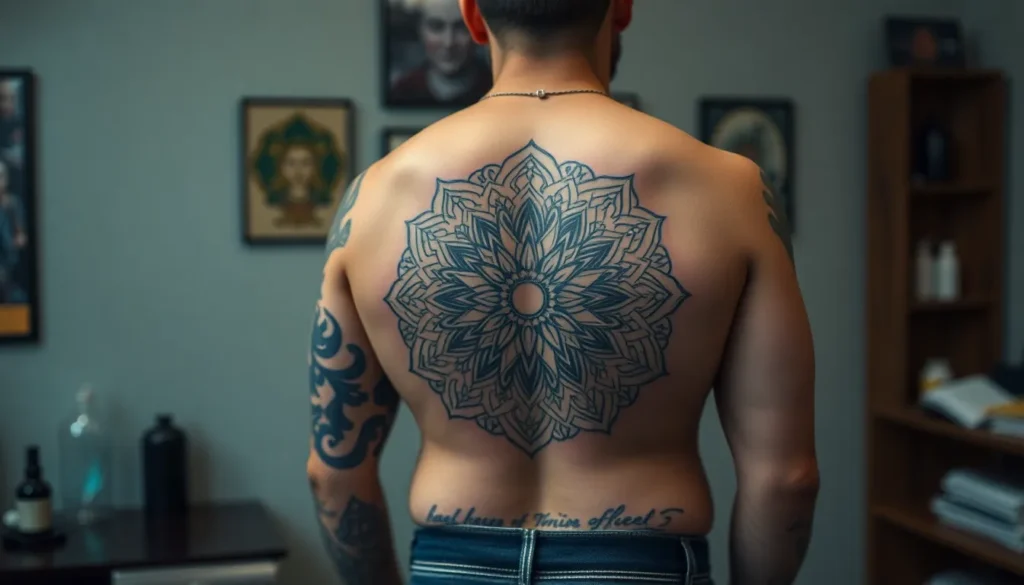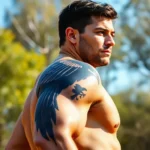We’ve witnessed a remarkable surge in mandela tattoo designs becoming the go-to choice for men seeking meaningful body art. These intricate geometric patterns don’t just look stunning – they represent balance, spirituality, and personal transformation that resonates deeply with modern masculinity.
Mandela tattoos offer men the perfect blend of artistic sophistication and symbolic depth. From bold tribal-inspired circles to minimalist geometric patterns, these designs adapt beautifully to various placement options like shoulders, chest, or forearms. The circular nature of mandalas creates a powerful visual impact that commands attention while maintaining an air of mystery.
What sets mandela tattoos apart is their incredible versatility and timeless appeal. Whether you’re drawn to traditional black ink designs or prefer incorporating color elements, these sacred geometric patterns can be customized to reflect your personal journey and aesthetic preferences. We’ll explore the most compelling mandela tattoo designs that’ll transform your vision into stunning reality.
Understanding the Significance of Mandala Tattoos for Men
Mandala tattoos carry profound meaning that resonates deeply with men seeking spiritual connection and personal growth. These sacred geometric patterns offer a powerful way to express inner transformation through permanent body art.
Spiritual and Cultural Meaning Behind Mandala Designs
Sacred geometry forms the foundation of every mandala tattoo, representing the universe’s infinite nature and cosmic order. Buddhism and Hinduism originally developed these circular patterns as meditation tools, with each intricate detail symbolizing different aspects of spiritual enlightenment.
Wholeness and completeness define the core essence of mandala symbolism, making these designs particularly meaningful for men handling life transitions. The Sanskrit word “mandala” translates to “circle” or “completion,” reflecting the journey toward self-realization and inner peace.
Balance between opposing forces emerges as a central theme in mandala tattoo meanings, with symmetrical patterns representing harmony between light and dark, masculine and feminine energies. Traditional Tibetan sand mandalas demonstrate this concept through their temporary nature, teaching acceptance of life’s impermanence.
Protection and spiritual guidance manifest through mandala tattoo designs, with many men choosing these symbols as personal talismans during challenging periods. Native American medicine wheels and Celtic knots share similar protective qualities, showing how circular sacred geometry transcends cultural boundaries.
Why Modern Men Choose Mandala Tattoo Symbolism
Personal transformation journeys drive many men to select mandala tattoos as visual representations of their growth and self-discovery. These designs serve as permanent reminders of overcoming obstacles, achieving goals, or embracing new life perspectives.
Masculine strength meets spiritual depth in mandala tattoo choices, allowing men to express both their warrior spirit and contemplative nature. Modern interpretations often incorporate bold tribal elements, geometric patterns, or realistic shading techniques that enhance the design’s masculine appeal.
Stress relief and mindfulness practices connect directly to mandala tattoo symbolism, with many men drawn to these designs after discovering meditation or yoga. The intricate patterns provide focal points for breathing exercises and mental centering, extending the tattoo’s benefits beyond aesthetic appeal.
Versatile placement options make mandala tattoos practical choices for professional men who want meaningful body art with discretion flexibility. Popular locations include the chest, back, shoulders, and forearms, where the circular designs can be scaled appropriately for maximum visual impact.
Customization possibilities attract men seeking unique expressions of their personal stories through mandala symbolism. Artists can incorporate family symbols, religious elements, nature motifs, or cultural references into traditional mandala frameworks, creating deeply personalized designs.
Choosing the Perfect Placement for Your Mandala Tattoo Design
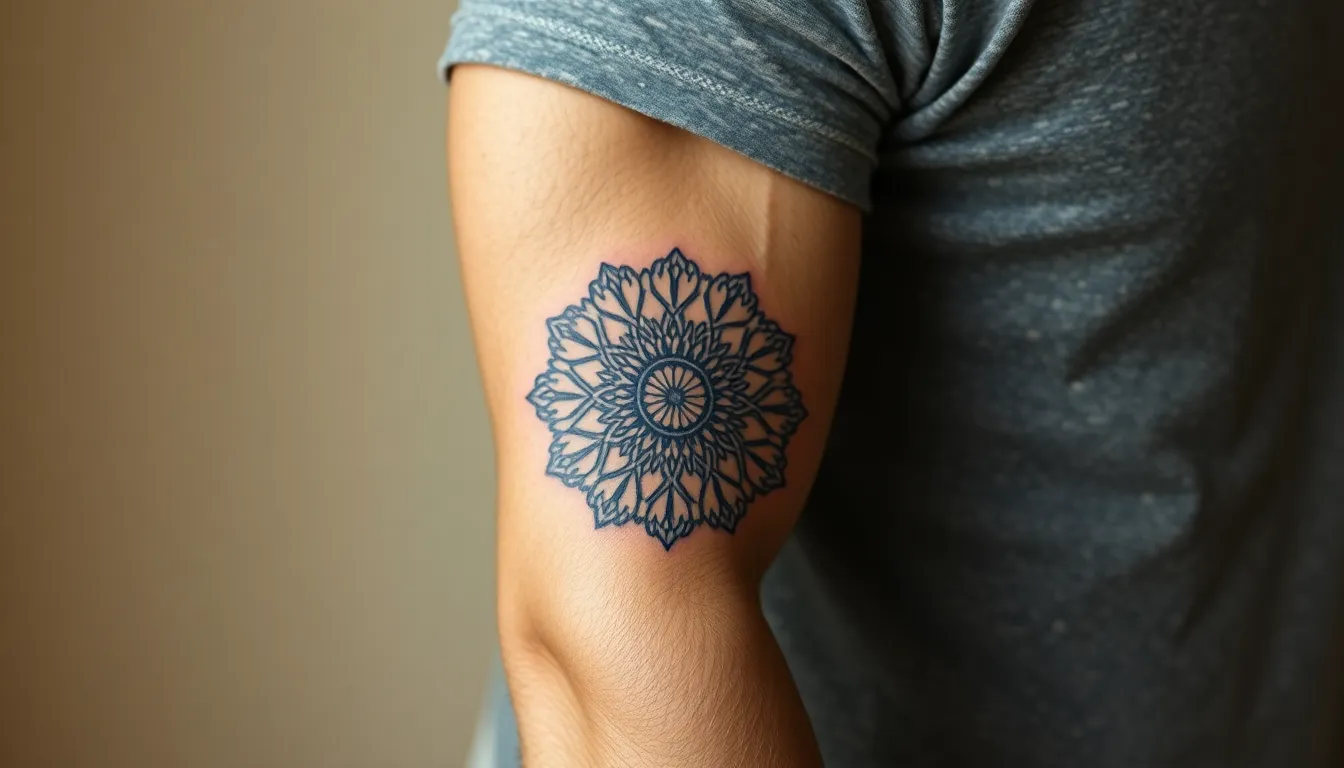
Placement selection directly impacts how well your mandala tattoo’s intricate geometric patterns will translate on your body. We recommend considering both visibility preferences and how the design’s symmetrical nature will appear on different body contours.
Popular Body Locations for Men’s Mandala Tattoos
Back and chest areas offer the most advantageous placement options for mandala tattoos among men. These expansive, flat surfaces provide ample space for showcasing detailed patterns while maintaining the design’s geometric integrity. Bold statement pieces work exceptionally well in these locations due to their generous canvas size.
Shoulder and upper arm placements create an ideal balance between visibility and discretion for mandala designs. Medium-sized mandalas suit these areas perfectly, delivering a masculine aesthetic that remains professionally appropriate. Men often choose these spots for their versatility in showing or concealing the artwork.
Forearms and thighs present alternative placement options that accommodate various lifestyle needs. While these locations are more commonly selected by women, they offer men the flexibility to display their mandala tattoos when desired. Coverage becomes simple with standard clothing choices in these areas.
Sleeve configurations allow for creative mandala integration with complementary design elements. Half or full sleeve tattoos can incorporate mandala patterns alongside geometric shapes or floral motifs. Connected designs flow seamlessly along the arm, creating visually striking continuous artwork.
Size Considerations for Different Placement Areas
Large mandala tattoos reach their full potential on back or chest placements where intricate details remain clearly visible. These spacious areas accommodate complex patterns without compromising the design’s symbolic meaning or visual impact. Rich detail and pattern complexity thrive in these generous spaces.
Medium-sized designs work optimally on upper arms and shoulders where pattern clarity remains intact. Balanced proportions ensure the mandala doesn’t overwhelm the placement area while maintaining its geometric precision. Visual appeal stays strong without sacrificing design integrity.
Smaller mandalas suit forearms and thighs where space limitations require careful size consideration. Symmetrical patterns must retain their visual balance even when scaled down for these narrower body areas. Design integrity depends on appropriate sizing for each exact location.
Sleeve integrated mandalas require thoughtful size planning to maintain flow and balance with surrounding elements. Proportional harmony becomes essential when combining mandala patterns with other design components throughout the sleeve composition.
Traditional Geometric Mandala Tattoo Styles for Men
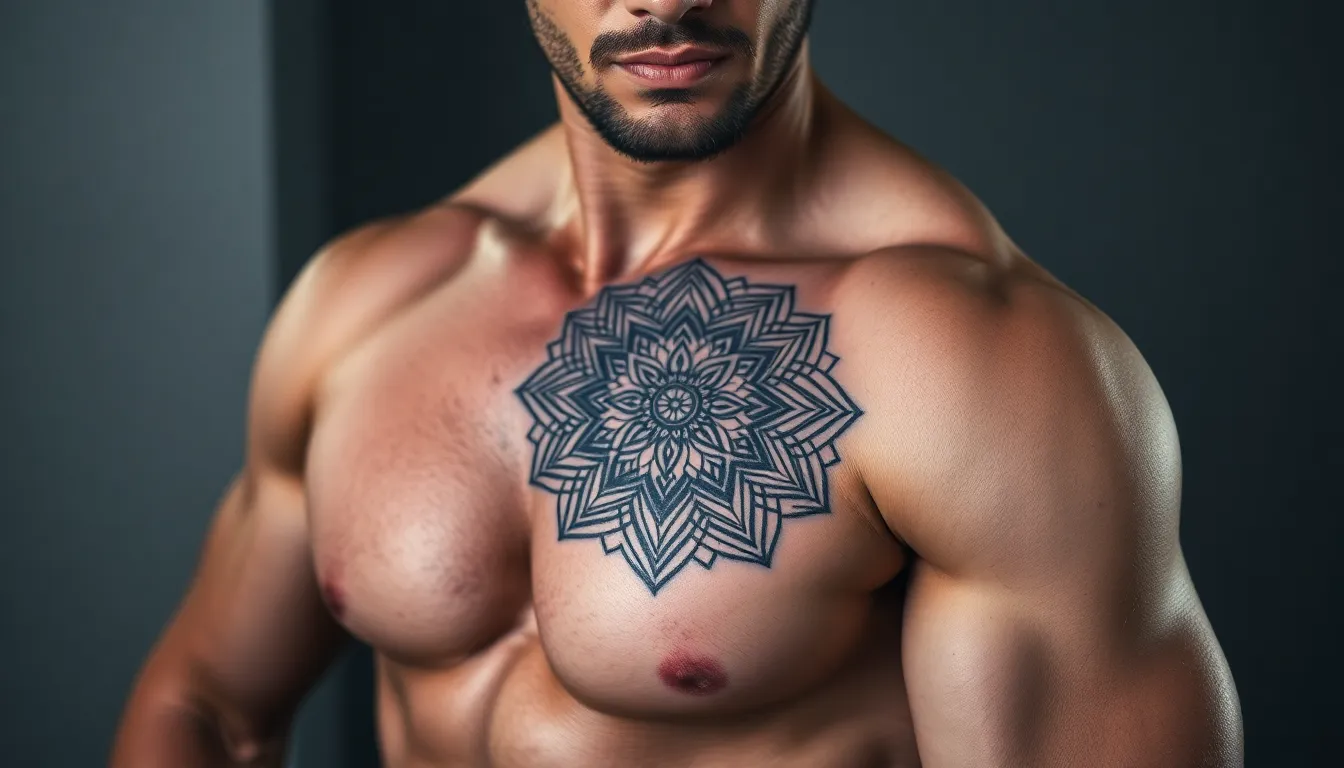
Traditional geometric mandala tattoos represent the foundation of this ancient art form, emphasizing precise symmetry and detailed line work that creates visually stunning body art. These designs combine spiritual symbolism with mathematical precision, making them particularly appealing to men who appreciate both artistic complexity and meaningful imagery.
Classic Circular Mandala Patterns
Circular mandala patterns form the most recognizable and popular style among men’s tattoo choices, featuring concentric layers that radiate outward from a central focal point. These intricate designs showcase lace-like details and repetitive geometric elements that create mesmerizing visual effects on the skin.
Symmetrical construction defines every circular mandala, with each layer building upon the previous one to create perfect balance and harmony. The outermost rings typically feature the most elaborate details, while the center often contains a simple yet powerful symbol that anchors the entire design.
Large body placements work best for circular mandala tattoos, with the chest, shoulders, and upper arms providing optimal canvas space for displaying the design’s full symmetry. These locations allow the intricate details to remain clear and impactful, ensuring the tattoo maintains its visual power over time.
Detailed line work requires skilled tattoo artists who specialize in geometric precision, as even minor inconsistencies can disrupt the mandala’s perfect symmetry. The repetitive patterns demand steady hands and mathematical accuracy to achieve the desired spiritual and aesthetic impact.
Sacred Geometry Integration in Mandala Designs
Sacred geometry elements elevate traditional mandala tattoos by incorporating metaphysically important shapes and patterns that add deeper spiritual meaning to the artwork. These ancient geometric forms represent universal principles and cosmic order, making them powerful additions to masculine mandala designs.
Flower of Life patterns appear frequently in men’s mandala tattoos, featuring overlapping circles that symbolize the interconnectedness of all existence. This sacred geometry element adds complexity and spiritual depth while maintaining the clean, mathematical aesthetic that appeals to male clients.
Metatron’s Cube integration brings angular precision to circular mandala designs, combining straight lines with curved elements to create visually striking contrasts. The cube’s geometric perfection represents divine order and universal balance, resonating with men seeking tattoos that reflect both strength and spirituality.
Sri Yantra incorporation introduces triangular elements that complement circular mandala patterns, creating ever-changing tension between different geometric forms. These sacred triangles symbolize the union of masculine and feminine energies, making them particularly meaningful for men exploring personal transformation and spiritual growth.
Enhanced symbolism results from combining multiple sacred geometry elements within a single mandala design, creating layered meanings that reflect the universe’s complexity and the wearer’s spiritual journey. This fusion approach allows for highly personalized tattoos that maintain traditional mandala aesthetics while incorporating individual spiritual beliefs and aspirations.
Modern Minimalist Mandala Tattoo Designs
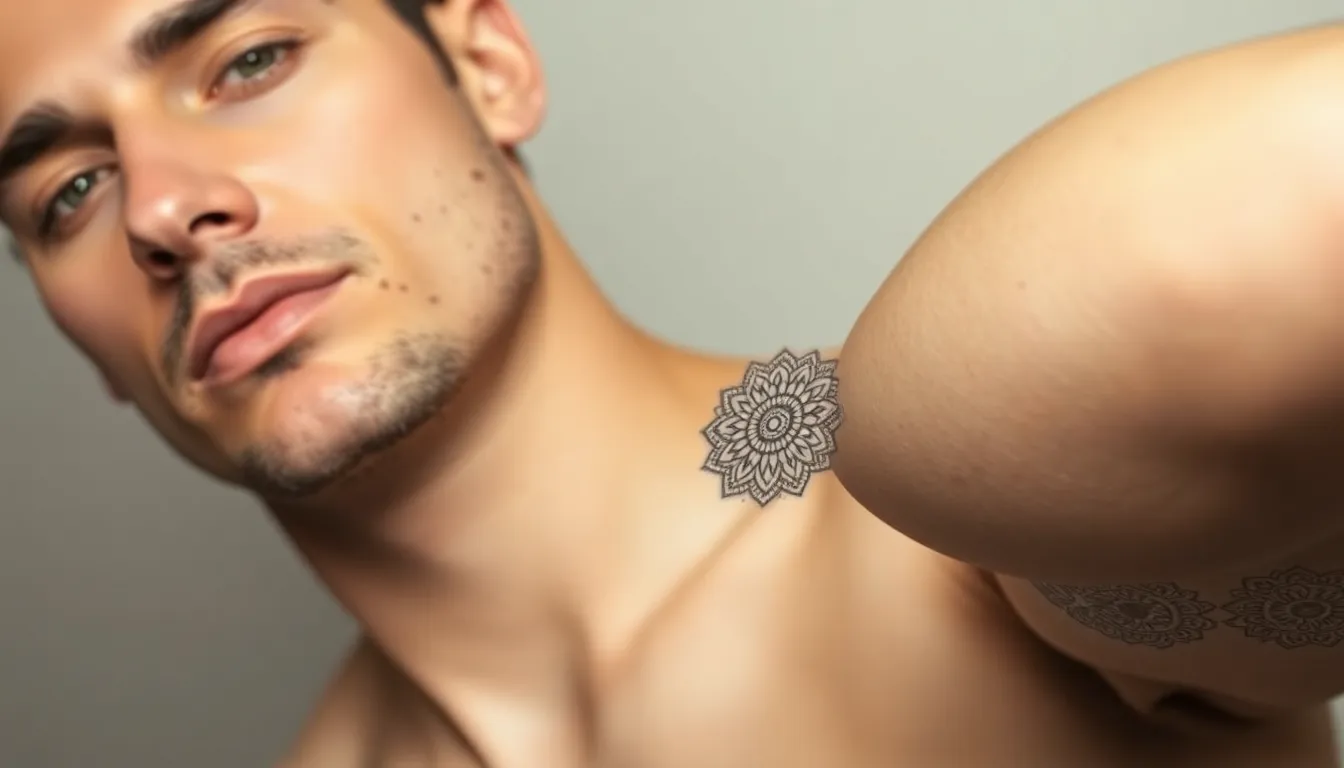
We’re witnessing a shift toward cleaner, more refined mandala tattoos that emphasize essential elements over complex details. Contemporary men gravitate toward these streamlined designs for their versatility and sophisticated aesthetic.
Simple Line Work Mandala Concepts
Precision drives the appeal of simple line work mandalas through their delicate, symmetrical patterns that create visual harmony without overwhelming detail. Artists construct these designs using fine lines that radiate from central points, forming repetitive patterns that enhance the spiritual nature of traditional mandala symbolism.
Versatility makes line work mandalas perfect for multiple body placements, from forearms and wrists to chest areas where the design can maintain its elegant proportions. Clean execution requires skilled tattoo artists who can maintain consistent line weights throughout the entire piece.
Symmetry and repetition form the foundation of these designs, allowing the tattoo to serve as a meditation focal point while remaining visually lightweight. Artists can combine these minimal patterns with other elements or leave them as standalone pieces that emphasize geometric purity.
Placement flexibility gives men options for both visible and discreet locations, with smaller line work mandalas working exceptionally well on wrists, ankles, or behind the ear. Larger versions can span across shoulders or upper arms while maintaining their delicate appearance.
Black and Gray Minimalist Approaches
Gradients of black and gray ink create depth without the distraction of vibrant colors, focusing attention on shadow and light contrasts within repetitive mandala patterns. This monochromatic approach adds sophistication while preserving the meditative qualities that make mandala tattoos spiritually important.
Timeless appeal characterizes black and gray mandala tattoos through their classic aesthetic that won’t date or fade in popularity over time. Artists use varying shades to create dimensional effects that enhance the geometric patterns without overwhelming the design’s essential simplicity.
Shadow work and light contrasts enhance the three dimensional quality of minimalist mandalas, making flat geometric patterns appear to have depth and movement. Skilled artists blend tones seamlessly to create subtle transitions that draw the eye toward the center point of the design.
Versatility in size makes these tattoos adaptable to various body areas, from intricate small pieces suitable for wrists to expansive designs that work beautifully across the chest or back. The monochromatic palette ensures these tattoos complement other existing ink work without clashing colors or competing for visual attention.
Professional settings often favor these understated designs because they maintain spiritual significance while appearing refined and sophisticated in conservative environments.
Bold Blackwork Mandala Tattoo Ideas
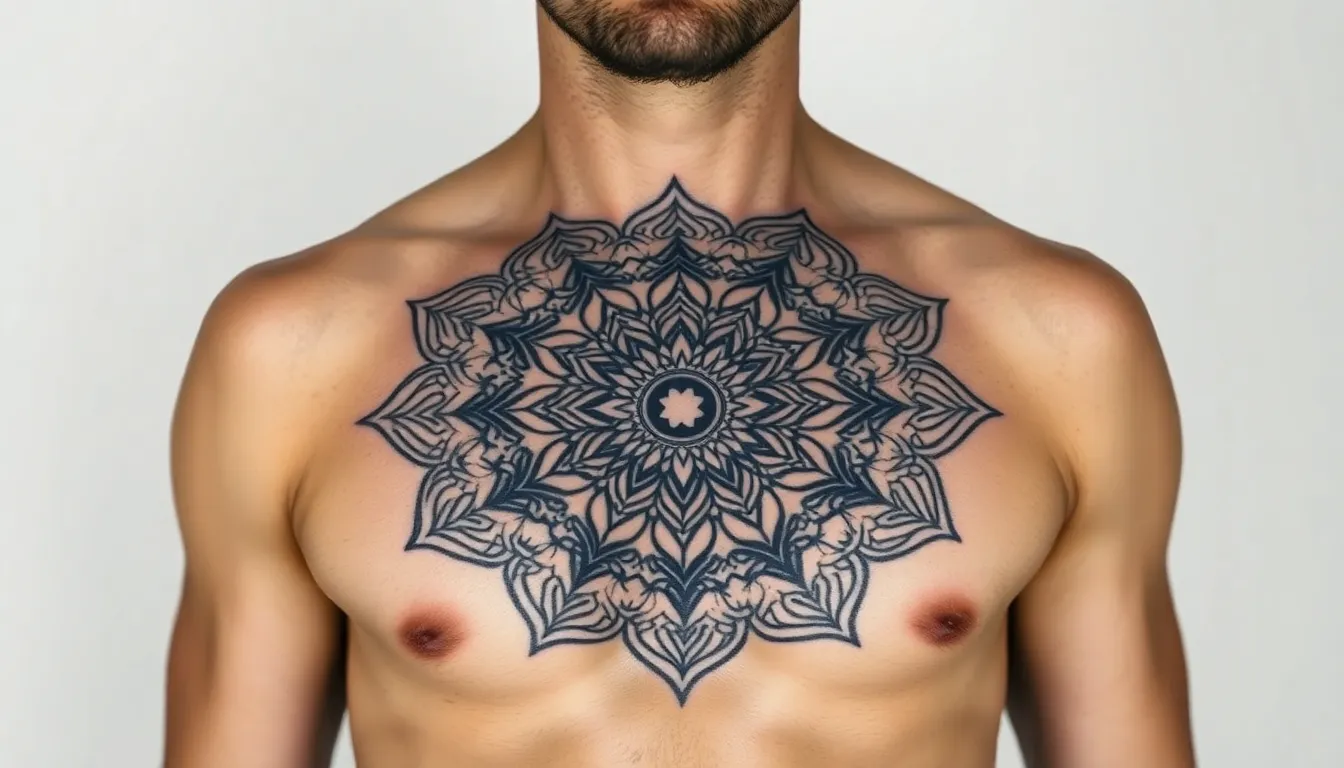
Bold blackwork mandala tattoos transform traditional sacred geometry into powerful masculine statements through heavy, solid black ink applications. These designs emphasize thick lines and strong contrasts that create visually striking effects across large body surfaces.
Heavy Black Ink Mandala Patterns
Dense black ink patterns define this tattoo style through layered elements and bold outlines that enhance visual intensity. We see these designs frequently incorporate concentric circles filled with complex line work, creating depth through strategic dot shading techniques. The heavy use of black ink makes these tattoos exceptionally durable while maintaining high contrast ratios that ensure long-lasting visual impact.
Chest and back placements work best for these substantial designs, providing ample surface area for intricate details to shine. Arms and forearms serve as popular alternative locations where the full geometric complexity can display properly. This style retains traditional spiritual meanings while offering men a powerful visual statement that symbolizes strength, balance, and spiritual connection.
Tribal-Inspired Mandala Fusion Designs
Tribal mandala fusion combines sacred geometry with primal tribal motifs, creating hybrid designs that merge cultural significance with meditative essence. Sharp angles and totemic symbols integrate seamlessly with traditional mandala patterns, producing tattoos that reflect both ancient wisdom and contemporary masculine aesthetics. These designs connect tribal symbolism with layered spiritual meanings, appealing to men seeking culturally important body art.
We observe these fusion styles incorporating elements like angular line work, cultural totems, and traditional tribal patterns within the mandala’s circular framework. The combination produces tattoos that honor both the meditative qualities of sacred geometry and the bold, primal nature of tribal art. This versatile approach allows for highly personalized designs that reflect individual heritage while maintaining the universal appeal of mandala symbolism.
Realistic 3D Mandala Tattoo Concepts
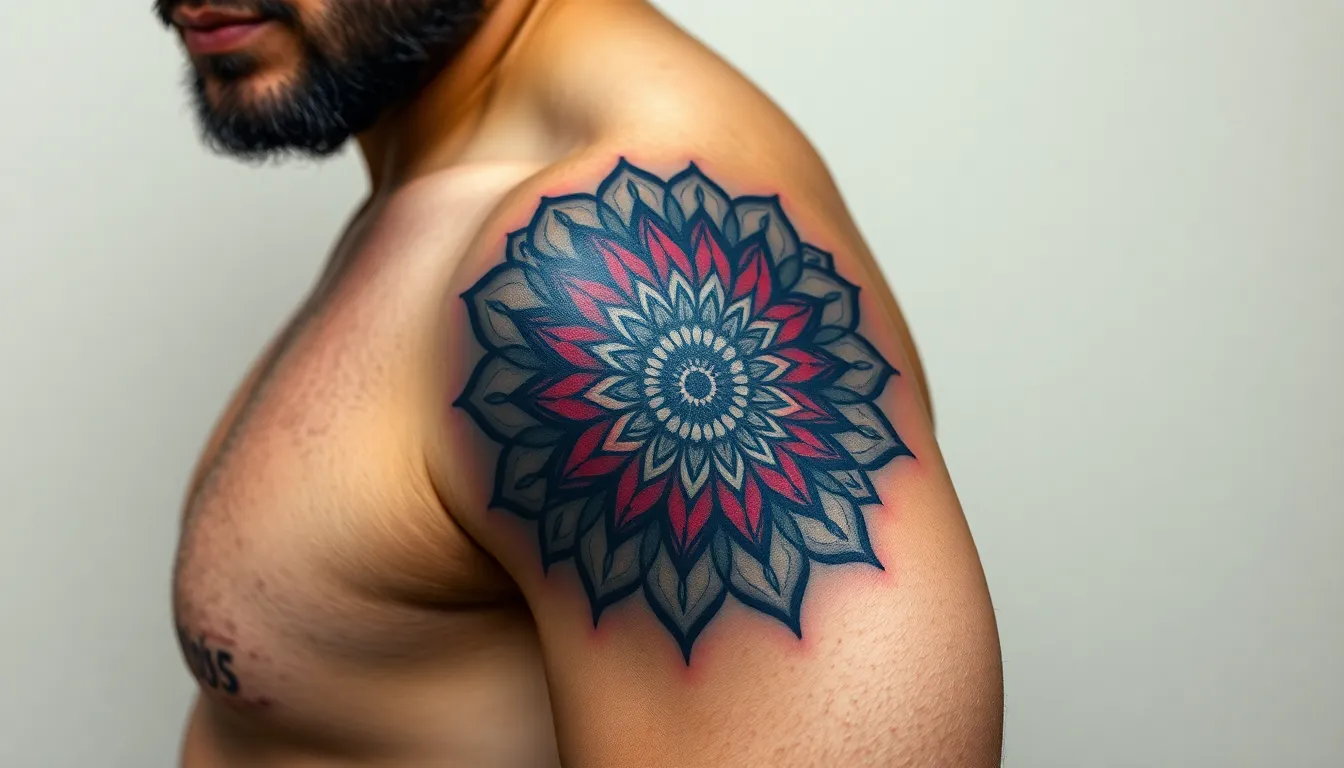
Realistic 3D mandala tattoos represent the cutting edge of sacred geometry body art, transforming traditional flat designs into stunning dimensional masterpieces. Artists achieve these lifelike effects through advanced shading and layering techniques that make intricate patterns appear to rise directly from the skin.
Three-Dimensional Mandala Effects
Three-dimensional mandala effects create visual illusions that captivate viewers through masterful manipulation of light and shadow. Artists blend highlights on raised geometric sections with deeper shading in recessed areas to simulate authentic volume and depth. These techniques produce mandalas that appear almost sculptural, with patterns seeming to float above the skin or spiral inward to create mesmerizing motion effects.
Complex interlocking shapes form the foundation of these dimensional designs, where each geometric element contributes to the overall depth perception. Strategic placement of highlights enhances the raised appearance of central focal points, while graduated shadows create natural-looking recessions between pattern layers. Modern geometric tattoo artistry combines seamlessly with traditional mandala elements to amplify the three-dimensional sensation.
Full sleeve geometric mandalas showcase the most dramatic 3D effects, wrapping entire arms in detailed forms that pop visually from every angle. These comprehensive designs demonstrate how dimensional mandala art can transform large body surfaces into living galleries of sacred geometry. Contemporary artists push boundaries by incorporating optical illusions that make certain pattern sections appear to extend beyond the skin’s natural surface.
Shadow and Depth Techniques in Mandala Art
Shadow techniques form the backbone of convincing 3D mandala artistry, requiring precise gradients of black and gray inks to establish authentic depth perception. Artists carefully emphasize layers within mandala structures using subtle shadowing that follows natural light principles. Professional tattooists employ dotwork methods alongside fine line shading to create tactile illusions that fool the eye into perceiving actual dimensionality.
Graduated shading creates smooth transitions between raised and recessed pattern areas, establishing visual hierarchy throughout complex geometric arrangements. Strategic shadow placement allows artists to guide the viewer’s eye through intricate mandala pathways while maintaining overall design balance. These depth-creating techniques require exceptional skill to execute properly, as improper shadows can flatten rather than enhance dimensional effects.
Ever-changing shadowing brings mandala tattoos to life by creating the impression of movement and organic growth across the skin surface. Advanced artists incorporate multiple light sources within their shading schemes to simulate realistic environmental lighting conditions. The resulting tattoos appear multidimensional rather than flat, possessing an almost living quality that shifts subtly with natural body movement and ambient lighting changes.
Sleeve Integration Mandala Tattoo Designs
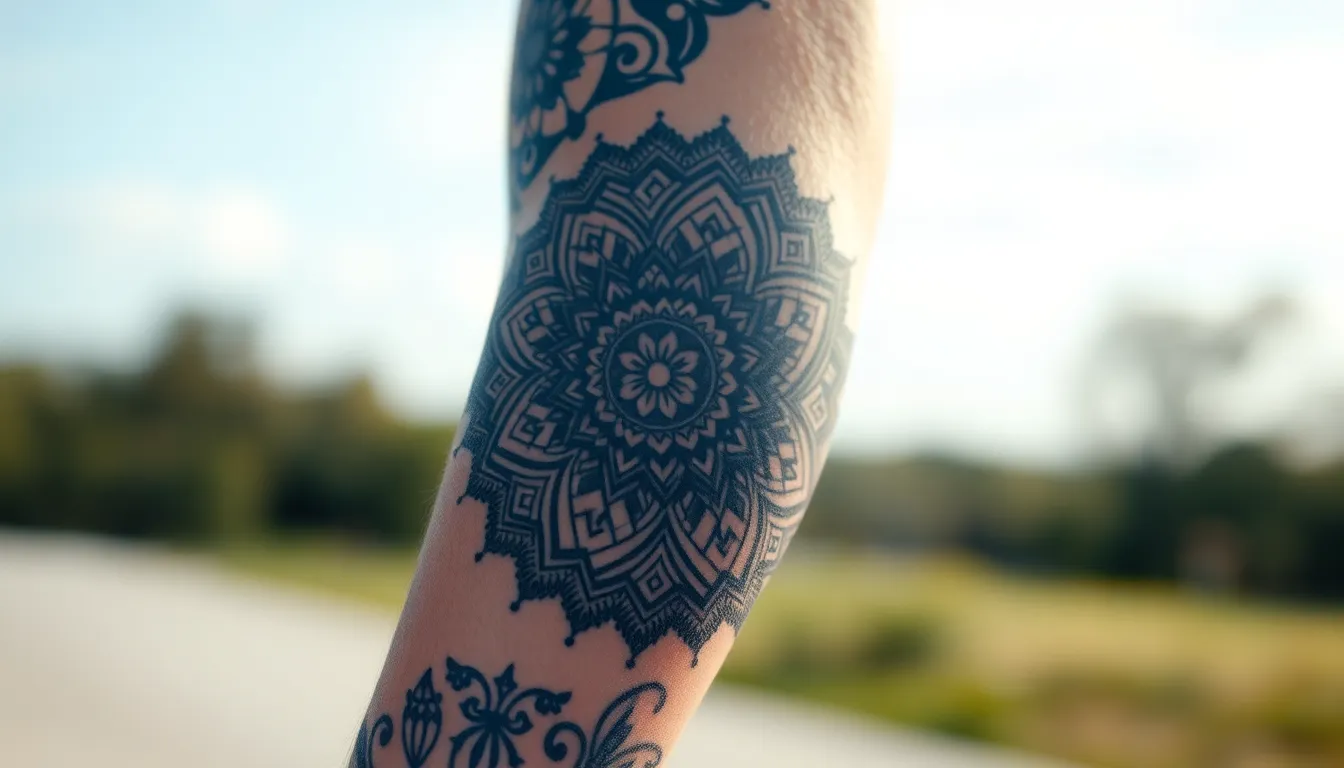
Creating cohesive sleeve designs with mandala patterns offers men the opportunity to showcase intricate sacred geometry across expansive canvases. These comprehensive tattoo approaches maximize visual impact while maintaining the spiritual essence that makes mandala artwork so compelling.
Full Sleeve Mandala Incorporation
Full sleeve mandala tattoos transform the entire arm from shoulder to wrist into a continuous canvas of geometric perfection. Artists use this extensive space to create large, complex symmetrical designs that flow naturally with the arm’s contours, ensuring each pattern complements the body’s natural movement. These comprehensive pieces often combine various mandala elements with complementary motifs such as nature scenes, tribal patterns, or geometric shapes to enhance both visual impact and personal significance.
Popular placement strategies for full mandala sleeves maximize exposure and detail across the upper arm and forearm sections. The shoulder area provides an ideal starting point for central mandala focal points, while the forearm allows for intricate pattern extensions that maintain visual continuity. Many men choose to incorporate dotwork detailing throughout their full sleeves, using small dots to build shading and texture that adds mesmerizing depth to the overall design.
Customization opportunities within full sleeve layouts enable personal expression through integrated symbols meaningful to the wearer. Family crests, natural elements, or hybrid artistic styles like watercolor effects can blend seamlessly with traditional mandala geometry. This personalization approach creates powerful individual statements while honoring the spiritual foundations of mandala symbolism.
Half Sleeve Mandala Layout Options
Half sleeve mandala tattoos cover either the upper arm or forearm, providing a balanced approach between visibility and commitment for men entering the mandala tattoo industry. These designs frequently feature central mandala elements surrounded by complementary patterns or expertly shaded backgrounds that create bold yet manageable areas for detailed artwork. The concentrated space allows artists to focus on precise geometric symmetry while maintaining the harmony and balance that defines quality mandala work.
Strategic placement options for half sleeves offer flexibility for future expansion or standalone impact. Upper arm half sleeves provide excellent coverage for professional settings while allowing for detailed mandala work across the deltoid and bicep areas. Forearm half sleeves deliver maximum visibility for intricate patterns, making them ideal for men who want to showcase their mandala artwork regularly.
Design integration within half sleeve layouts can serve as stepping stones toward full sleeve development. Many men begin with half sleeve mandala tattoos and later extend them into comprehensive arm coverage, creating cohesive design narratives that evolve over time. This approach allows for careful planning and ensures that each addition enhances rather than competes with existing mandala elements.
The versatility of half sleeve mandala designs accommodates various artistic approaches, from bold blackwork applications to subtle dotwork techniques. Artists can incorporate multiple light sources and shadow work to create dimensional effects that make patterns appear to rise from the skin, adding sophisticated depth to these meaningful spiritual tattoos.
Color Mandala Tattoo Ideas for Men

While black and gray mandalas offer timeless elegance, color mandala tattoos create vibrant expressions of personal meaning and artistic flair. We’ll explore how strategic color choices can transform your mandala design into a powerful visual statement.
Vibrant Traditional Color Schemes
Traditional mandala tattoos showcase bold colors like reds, blues, greens, and yellows that illuminate intricate geometric patterns with stunning clarity. Red ink energizes the design while representing passion and strength, making it particularly appealing for men seeking powerful symbolic expression. Blue tones bring tranquility and depth to the mandala’s spiritual essence, often anchoring the design’s meditative qualities.
Green elements symbolize growth and harmony within the geometric framework, creating balance between vibrant sections. Yellow accents highlight exact pattern details and represent enlightenment, drawing the eye to focal points throughout the design. Many men choose these contrasting colors with sharp definition to maintain the tattoo’s visual impact and ever-changing presence on skin.
We recommend keeping color boundaries distinct within geometric sections to preserve the mandala’s structural integrity. Artists often use these traditional color schemes in layered sleeve designs, where multiple mandala patterns create complex visual narratives across expansive body surfaces.
Watercolor Mandala Tattoo Techniques
Watercolor techniques transform precise mandala geometry into flowing artistic expressions where colors blend seamlessly beyond traditional line boundaries. This modern approach softens the rigid structure while maintaining the mandala’s core symbolism, creating dreamy ethereal effects that appeal to men seeking contemporary spiritual body art.
Artists apply watercolor effects around geometric mandala cores, allowing colors to bleed and flow naturally outside the structured patterns. Blues and purples often create atmospheric backgrounds, while warm oranges and reds add energy to exact design elements. The technique emphasizes creativity and individuality, making each watercolor mandala unique to the wearer’s vision.
We’ve seen successful watercolor mandalas incorporate splash effects and color gradients that enhance the tattoo’s three dimensional appearance. These designs work exceptionally well on larger body areas like the back and chest, where the flowing colors have space to create their full visual impact without compromising the mandala’s geometric precision.
Strategic color placement in watercolor mandalas can highlight personal meaning while maintaining the design’s meditative essence. Many men combine traditional black line work with selective watercolor elements, creating balanced compositions that honor both classic mandala aesthetics and modern artistic innovation.
Chest and Back Mandala Tattoo Designs

Building upon our exploration of sleeve configurations, chest and back placements offer the most expansive canvases for showcasing intricate mandala artistry. These prime body locations enable artists to create truly breathtaking designs that serve as powerful statements of masculine spirituality and personal transformation.
Large-Scale Mandala Centerpiece Ideas
Chest mandala tattoos transform the torso into a bold centerpiece that symbolizes balance, harmony, and spiritual growth. Artists use the broad surface area to incorporate detailed dotwork and fine line techniques, creating intricate patterns that invite contemplation and reflection. We often see these designs spanning both pectorals or centering on the sternum, maximizing their visual impact through strategic positioning.
Back mandala designs showcase expansive geometric patterns that make powerful visual statements across the entire canvas. These placements allow for complex symmetrical beauty that flows naturally with the body’s contours, improving the overall aesthetic appeal. Artists frequently customize these large scale pieces by incorporating personal symbols such as family crests or meaningful natural elements, creating unique and personalized designs.
Blended artistic styles add depth and individuality to these centerpiece tattoos. Many men choose to combine traditional mandala elements with tribal patterns or watercolor effects, resulting in one of a kind artistic expressions. These hybrid approaches maintain the sacred geometry’s meditative qualities while adding contemporary masculine flair.
| Design Element | Chest Placement | Back Placement |
|---|---|---|
| Size Range | 8-12 inches diameter | 12-18 inches diameter |
| Detail Level | High intricate patterns | Maximum complexity possible |
| Session Requirements | 2-4 sessions typical | 4-6 sessions average |
| Healing Time | 2-3 weeks standard | 3-4 weeks extended |
Symmetrical Mandala Placement Strategies
Centered positioning preserves the essential balance that defines mandala symbolism. For chest tattoos, artists carefully align designs along the sternum or create symmetrical compositions spanning both pectorals to maximize visual harmony. This strategic placement ensures the tattoo maintains its spiritual significance while creating stunning aesthetic appeal.
Spinal alignment on the back emphasizes the mandala’s radial symmetry and spiritual symbolism. Artists position these designs centered along the spine to create perfect balance from all viewing angles. This placement strategy connects with the body’s natural energy centers, improving the tattoo’s spiritual resonance.
Natural body contours guide placement decisions to preserve the mandala’s geometric integrity. Tattoo artists carefully plan designs to align with the body’s inherent symmetry, ensuring the artwork looks harmonious whether viewed from front, back, or side angles. These strategic considerations maintain the mandala’s sacred proportions while adapting to individual body shapes.
Professional planning techniques involve detailed stenciling and positioning tests before permanent application. Artists use temporary transfers to visualize how the mandala will interact with natural muscle definition and body movement. This meticulous approach guarantees that the final tattoo maintains its symmetrical beauty through all physical positions and poses.
Finding the Right Tattoo Artist for Your Mandala Design
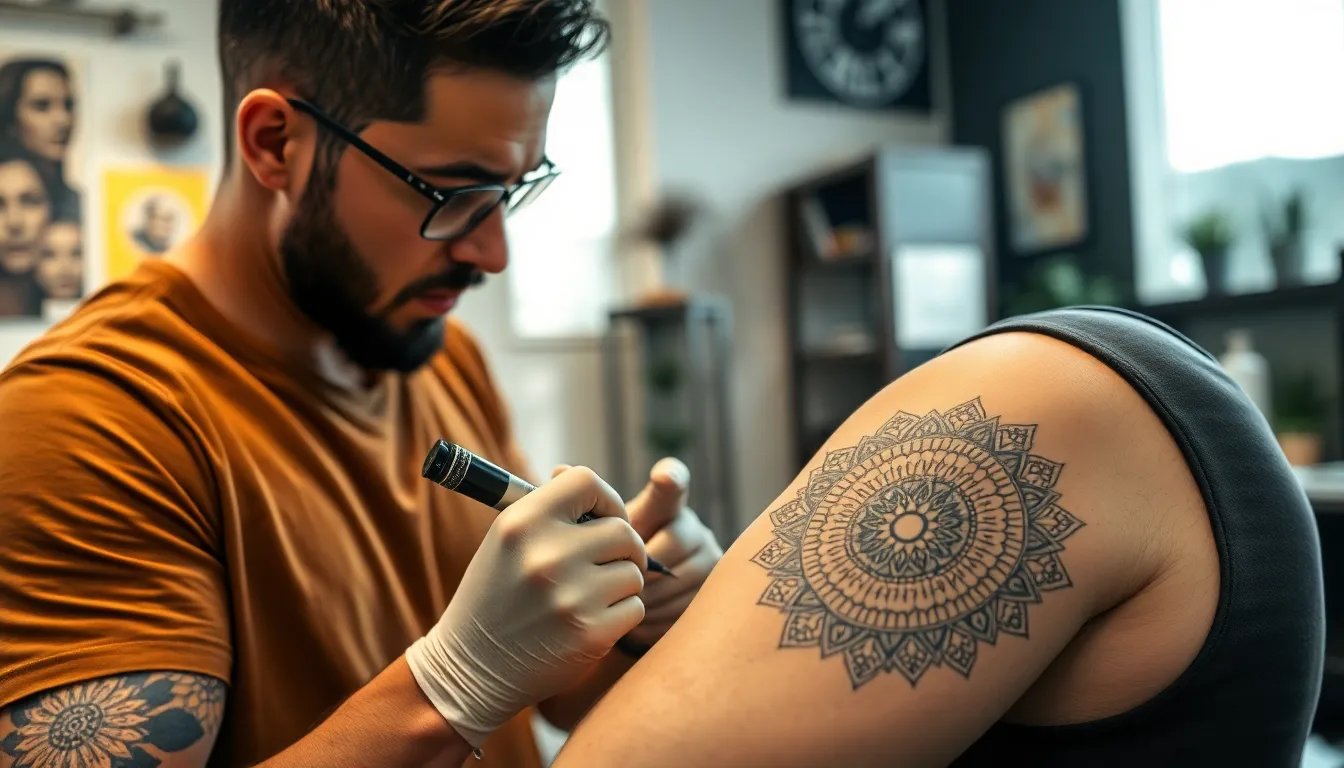
Selecting the perfect artist determines whether your mandala tattoo achieves the precision and spiritual significance you’re seeking. The complexity of sacred geometry demands exact expertise that not every tattoo artist possesses.
Researching Mandala Tattoo Specialists
Prioritize artists who specialize in fine line and geometric tattoos since mandalas require exceptional precision and attention to detail. Portfolio reviews on platforms like Pinterest and Instagram reveal the quality of their mandala work and artistic consistency.
Experience with symmetrical, layered designs becomes crucial when you’re considering larger pieces or mandala sleeves. Artists who understand the mathematical principles behind sacred geometry create more balanced and visually striking results.
Local tattoo studios often provide recommendations for artists known for spiritual or geometric tattoos within your area. Studio reputation and artist specialization combine to ensure you’re working with someone who understands mandala symbolism.
Check for artists with documented mandala experience rather than general tattoo portfolios. Mandala specialists understand the cultural significance and technical requirements that make these designs meaningful and visually compelling.
Questions to Ask Your Tattoo Artist
How much experience do you have with mandala tattoo designs specifically? This question establishes their expertise level and helps you gauge their understanding of sacred geometry principles.
Can you show me examples of your past mandala tattoos? Direct portfolio evidence demonstrates their ability to execute symmetrical patterns and maintain consistent line quality throughout complex designs.
What is your process for ensuring symmetry and precision in the design? Understanding their technical approach reveals whether they use proper geometric construction methods or digital design tools.
How do you customize mandala patterns to fit the placement on the body? Body contours affect mandala proportions, and experienced artists adjust designs to maintain visual balance across curved surfaces.
What aftercare advice do you recommend to preserve the tattoo’s details? Proper healing protocols protect the fine line work that makes mandala tattoos visually stunning and spiritually meaningful.
Are there options for semi-permanent mandala tattoos if I want to try the design first? Testing placement and size through temporary options helps ensure your final tattoo meets your expectations before committing to permanent ink.
Conclusion
Mandala tattoos represent far more than decorative body art—they’re powerful symbols of personal transformation and spiritual growth that resonate deeply with modern men. We’ve explored how these sacred geometric designs offer endless possibilities for customization while maintaining their profound symbolic meaning.
Whether you’re drawn to bold blackwork statements or subtle minimalist approaches the key lies in finding an experienced artist who understands the intricate balance between aesthetic beauty and spiritual significance. Remember that mandala tattoos are lifetime commitments that should reflect your personal journey and values.
From chest centerpieces to full sleeve masterpieces these designs offer versatile placement options that can adapt to your lifestyle and professional needs. We encourage you to take time researching artists and considering all design elements before making your final decision.
Your mandala tattoo will serve as a daily reminder of balance wholeness and your ongoing path toward personal enlightenment.
Frequently Asked Questions
What makes mandala tattoos popular among men?
Mandala tattoos combine artistic sophistication with deep spiritual symbolism, representing balance, transformation, and personal growth. Their versatile designs range from bold tribal patterns to minimalist styles, making them appealing to men seeking meaningful body art that reflects both masculine strength and spiritual depth while offering customization options in various sizes and placements.
What is the spiritual meaning behind mandala tattoos?
Mandala tattoos originate from sacred geometry and symbolize the universe’s infinite nature, cosmic order, wholeness, and completeness. Rooted in Buddhism and Hinduism traditions, they represent spiritual connection, personal transformation, and serve as protective talismans. Many men choose them as visual representations of their spiritual journeys and life transitions.
Where are the best body placements for men’s mandala tattoos?
Popular placements include the back and chest for large, detailed designs, and shoulders/upper arms for balanced visibility and discretion. Forearms and thighs offer alternative options for various lifestyle needs. Large mandalas work best on expansive surfaces, while smaller designs require careful sizing to maintain clarity and visual impact.
What are the different styles of mandala tattoos available?
Mandala tattoos come in various styles including traditional geometric patterns with precise symmetry, modern minimalist designs with clean lines, bold blackwork tattoos with heavy ink applications, tribal-inspired fusion designs, realistic 3D concepts with dimensional effects, and colorful options ranging from traditional color schemes to watercolor techniques.
How do I choose the right tattoo artist for a mandala design?
Look for artists specializing in fine line and geometric tattoos with proven experience in symmetrical, layered designs. Review their portfolios for mandala work, ask about their customization process, and discuss your spiritual intentions. Consider semi-permanent options to test designs before committing to permanent ink.
Can mandala tattoos be incorporated into sleeve designs?
Yes, mandala tattoos work excellently in sleeve configurations. Full sleeves transform the entire arm into a continuous geometric canvas, while half sleeves offer balanced visibility with room for future expansion. These designs can integrate various mandala elements with complementary motifs for enhanced visual impact and personal expression.
Are colored mandala tattoos suitable for men?
Absolutely. While black and gray designs offer timeless elegance, colored mandala tattoos allow for personal expression and artistic flair. Traditional color schemes use bold reds, blues, greens, and yellows for symbolic meaning, while watercolor techniques create contemporary, ethereal effects that maintain the mandala’s spiritual significance.
Do mandala tattoos help with stress relief and mindfulness?
Yes, the intricate patterns of mandala tattoos are linked to stress relief and mindfulness practices. Their geometric precision and meditative qualities appeal to men who engage in meditation or yoga. The process of contemplating these sacred designs can promote mental clarity and spiritual grounding.
